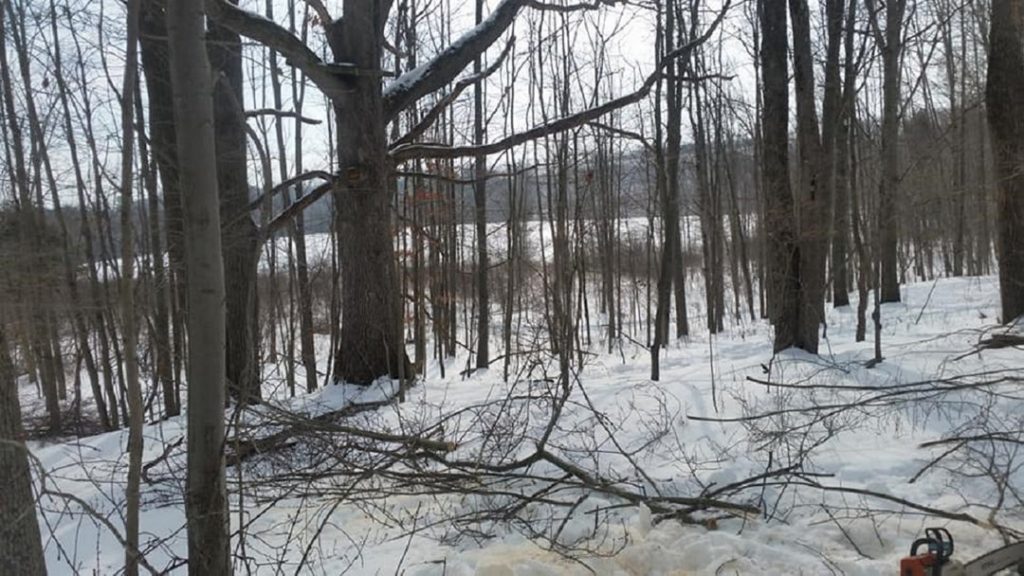BY CRAIG MORGAN
That Sunday afternoon command of “Gentlemen, start your engines” is not only for NASCAR drivers.
So too are habitat fanatics starting their engines — on chainsaws, that is — as the cutting season is under way. Deer seasons in Pennsylvania closed two months ago, signaling the time for prime tree cutting and pruning time to begin.
A chainsaw can be a deer and other wildlife’s best friend, as being able to see 100 yards, and sometimes more, in the forest may look good to some, but remember, beauty is in the eyes of the beholder. Just like a manicured lawn, open woods just doesn’t do much for wildlife.
There have been many suggestions for turning back yards into wildlife havens for pollinators and wildlife. A quick search on the internet and many examples can be seen.
For deer, turkeys and many other wildlife species the hum of a chainsaw is a game changer. Laying buds within range of deer, rabbits and other wildlife, at the time of year when food supplies are dwindling, hard to get to because of snow cover and fat reserves on wildlife are being depleted, may be the difference between life and death.
Plus, it’s the growing season for their offspring waiting to be born. Plus, creating that newly available food supply is only the beginning.
If one implements “hinge cutting” (cutting only partway through a tree and pushing it over), the tree will continue to grow for years, providing food within reach of wildlife. In addition, the daylight created on the forest floor will be a rebirth of all kinds of food for wildlife.
Allowing sunlight to reach the bed of the forest will allow seeds to sprout, creating a whole new host of foods. Recent studies have shown that deer droppings also spread seed, and what better food than what deer have already liked to eat.
Check out www.whitetailambushsecrets.com for an in-depth look at this proven whitetail deer habitat phenomenon. Basically, a horizontal cut is made anywhere up to 5 feet high, depending whether cutting for bedding areas or blocking, about three-fourths of the way into the tree. Then push or pull with an arborist hook, which can be made by welders such as Bill Keller of Orwigsburg, and/or use wedges to drop the tree leaving about 25% of the cambium layer attached.
In most cases, the tree will survive another 5-7 years, providing food and cover, but remember, safety first so check out the videos on the secrets website for all the details. One tip: If cutting too far, the tree will fall on its own and the hinge will probably break.
Some species of trees do not hinge well and aspen regenerate from the roots, so learn to identify tree species. To paraphrase a comment made by the video presenter while cutting a walnut tree: “Now some people will say, this walnut tree will be worth a lot of money one day, but I say, if I keep harvesting big buck on this land like I have been, it will be worth a lot more than that tree.”
Of course, if lucky enough to have marketable timber many of the same results can be accomplished by a timber harvest. A select cut (taking out certain trees) and a biodiversity clear-cut have unbelievable wildlife benefits.
If one considers carrying capacity of forest land, (i.e. how many deer the forest can support), a mature stand of timber supports 20 deer per square mile, pole timber 5 and clear-cuts 60 deer per square mile for about 15 years. Depending on the amount of forested area, various size clear-cut blocks create more edge and deer movement.
The edge and biodiversity created by hinge or other cutting is crucial to many species of wildlife, and the browse, now within the reach of deer, can continue for seven years, let alone the new growth from allowing light to reach the forest floor. In addition, the buds on the trees just downed will be attacked by deer and are especially valuable to the health of the herd during winter.
More food means healthier deer and other wildlife, so do a little cutting this winter and put out a game camera. You will be amazed how fast deer will come to feed on the buds.
The sounds of a chainsaw are like a dinner bell to deer, and first-hand experience on several timber cuts proves this. On one occasion, 20 deer followed by a mature 10-point buck traveled hundreds of yards out of their normal evening feeding pattern to a cut in March, the same day.
On another occasion a number of aspen were cut and it snowed about six inches overnight. The area looked like a cow pasture the next morning with all the deer tracks eating the now available tree buds.
And, finally, here is some more food for thought from the secrets website: “If you enjoy making habitat more than you like hunting, then you are a habitat fanatic.”
Morgan is a member of the Pennsylvania Outdoor Writers Association. Contact the writer: outdoors@republicanherald.com



